[14] Visitors with street-legal four-wheel drive vehicles may continue past the end of the park's main road to Medano Pass on 22 miles (35km) of unpaved road, crossing the stream bed of Medano Creek nine times and traversing 4 miles (6.4km) of deep sand. All national park horse camping areas are in the wilderness in designated backcountry campsites or other wilderness areas at least 0.25mi (0.4km) from roads or trails.
[57], In 1999, the Nature Conservancy purchased surrounding state-owned land. [11], Visitors must walk across the wide and shallow Medano Creek to reach the dunes in spring and summer. In 1776, Juan Bautista de Anza and an entourage of men and livestock probably passed near the dunes as they returned from a punitive raid against a group of Comanches.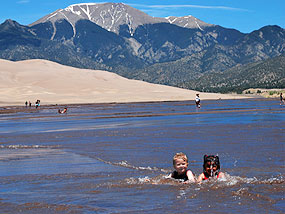 By the 1920s, the dunes had become a source of pride for local people, and a potential source of tourist dollars for local businesses. Although many settlers arrived via the trails from Santa Fe or La Veta Pass, several routes over the Sangre de Cristos into the valley were well-known to American Indians and increasingly used by settlers in the late 1800s. At subalpine elevations near the tree line grow krummholz (meaning "crooked wood")trees which are stunted and twisted due to high winds, snow, ice, short growing seasons, and shallow, poorly developed soils. The dunes were likely a visible landmark for travelers along the trail. [13][6] Most of the park's grasslands, shrublands and wetlands have no established trails but are generally open to hiking. This wilderness is the only one in the U.S. that protects a saltbush-greasewood ecosystem and includes the entire dunefield as well as much of the area west of the dunes. [6], The oldest evidence of humans in the area dates back about 11,000 years. [47][48], The national preserve adjacent to the national park is also managed by the National Park Service and seasonal hunting is permitted there. Many species nest in the mountains, forests, grasslands, or wetlands during the summer. Grassland species such as elk also use these waters for drinking. The land includes the area presently occupied by the bison herd, as well as adjacent meadows and wetland areas. [51], In 1976, the U.S. Congress designated the Great Sand Dunes Wildernessa wilderness area encompassing 32,643 acres (51sqmi; 132km2) within the monument. In the late 17th century, Diego de Vargas, a Spanish governor of Santa Fe de Nuevo Mxico, became the first European on record to enter the San Luis Valley. [10], The riparian zone follows creeks through the subalpine and montane ecosystems at Great Sand Dunes. The Sand Ramp Trail traverses between the dunefield and the mountains, connecting the park's campground to Medano Pass Road (follow the road up to Medano Lake and Pass), as well as the base of the Sand Creek Trail. The surges occur at an average interval of about 20 seconds.
By the 1920s, the dunes had become a source of pride for local people, and a potential source of tourist dollars for local businesses. Although many settlers arrived via the trails from Santa Fe or La Veta Pass, several routes over the Sangre de Cristos into the valley were well-known to American Indians and increasingly used by settlers in the late 1800s. At subalpine elevations near the tree line grow krummholz (meaning "crooked wood")trees which are stunted and twisted due to high winds, snow, ice, short growing seasons, and shallow, poorly developed soils. The dunes were likely a visible landmark for travelers along the trail. [13][6] Most of the park's grasslands, shrublands and wetlands have no established trails but are generally open to hiking. This wilderness is the only one in the U.S. that protects a saltbush-greasewood ecosystem and includes the entire dunefield as well as much of the area west of the dunes. [6], The oldest evidence of humans in the area dates back about 11,000 years. [47][48], The national preserve adjacent to the national park is also managed by the National Park Service and seasonal hunting is permitted there. Many species nest in the mountains, forests, grasslands, or wetlands during the summer. Grassland species such as elk also use these waters for drinking. The land includes the area presently occupied by the bison herd, as well as adjacent meadows and wetland areas. [51], In 1976, the U.S. Congress designated the Great Sand Dunes Wildernessa wilderness area encompassing 32,643 acres (51sqmi; 132km2) within the monument. In the late 17th century, Diego de Vargas, a Spanish governor of Santa Fe de Nuevo Mxico, became the first European on record to enter the San Luis Valley. [10], The riparian zone follows creeks through the subalpine and montane ecosystems at Great Sand Dunes. The Sand Ramp Trail traverses between the dunefield and the mountains, connecting the park's campground to Medano Pass Road (follow the road up to Medano Lake and Pass), as well as the base of the Sand Creek Trail. The surges occur at an average interval of about 20 seconds. 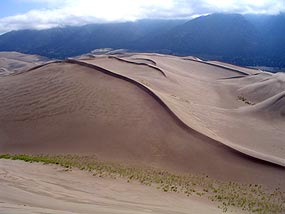
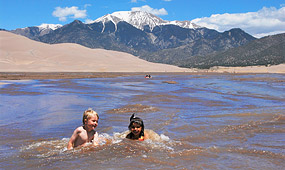 The Great Sand Dunes are located in the high elevation desert of the San Luis Valley at about 7,694ft (2,345m), just west of the Sangre de Cristo Range. [32][33], Among the flowering plants are alpine phlox, dwarf clover, alpine forget-me-not, fairy primrose, alpine aven, Indian paintbrush, lousewort, blue-purple penstemon, aspen daisy, western paintbrush, elephantella, snow buttercups, scurfpea, Indian ricegrass, blowout grass, prairie sunflower, Rocky Mountain beeplant, rubber rabbitbrush, speargrass, small-flowered sand verbena, narrowleaf yucca, prickly pear cactus, Rocky Mountain iris, and white water buttercup. Partially rebuilt at times in the 1930s through the 1950s, the road was repeatedly closed due to flood damage and is now a hiking trail. He was followed in 1853 by Captain John Gunnison of the Corps of Topographical Engineers. Large amounts of sediment from the volcanic San Juan Mountains continued to wash down into these lakes, along with some sand from the Sangre de Cristo Range. Sediments from both mountain ranges filled the deep chasm of the valley, along with huge amounts of water from melting glaciers and rain. Other families homesteaded near the dunes as well, including the Teofilo Trujillo family whose sheep and cattle ranch in the valley later became part of the MedanoZapata Ranch, owned by the Nature Conservancy since 1999. Almost 90% of the sand deposit is found in the sand sheet, while the remainder is found in the dunefield. The first historic peoples to inhabit the area were the Southern Ute Tribe; Apaches and Navajo also have cultural connections in the area. [32], Mammals includefrom alpine tundra to low elevation grasslandspika, yellow-bellied marmot, bighorn sheep, black bear, snowshoe hare, Abert's squirrel, gray and red foxes, cougar, coyote, mule deer, water shrew, beaver, porcupine, kangaroo rat, badger, pronghorn, and elk. The sabkha forms where sand is seasonally saturated by rising ground water. The Herards grazed and bred cattle in the mountain meadows, raised horses, and established a trout hatchery in the stream.
The Great Sand Dunes are located in the high elevation desert of the San Luis Valley at about 7,694ft (2,345m), just west of the Sangre de Cristo Range. [32][33], Among the flowering plants are alpine phlox, dwarf clover, alpine forget-me-not, fairy primrose, alpine aven, Indian paintbrush, lousewort, blue-purple penstemon, aspen daisy, western paintbrush, elephantella, snow buttercups, scurfpea, Indian ricegrass, blowout grass, prairie sunflower, Rocky Mountain beeplant, rubber rabbitbrush, speargrass, small-flowered sand verbena, narrowleaf yucca, prickly pear cactus, Rocky Mountain iris, and white water buttercup. Partially rebuilt at times in the 1930s through the 1950s, the road was repeatedly closed due to flood damage and is now a hiking trail. He was followed in 1853 by Captain John Gunnison of the Corps of Topographical Engineers. Large amounts of sediment from the volcanic San Juan Mountains continued to wash down into these lakes, along with some sand from the Sangre de Cristo Range. Sediments from both mountain ranges filled the deep chasm of the valley, along with huge amounts of water from melting glaciers and rain. Other families homesteaded near the dunes as well, including the Teofilo Trujillo family whose sheep and cattle ranch in the valley later became part of the MedanoZapata Ranch, owned by the Nature Conservancy since 1999. Almost 90% of the sand deposit is found in the sand sheet, while the remainder is found in the dunefield. The first historic peoples to inhabit the area were the Southern Ute Tribe; Apaches and Navajo also have cultural connections in the area. [32], Mammals includefrom alpine tundra to low elevation grasslandspika, yellow-bellied marmot, bighorn sheep, black bear, snowshoe hare, Abert's squirrel, gray and red foxes, cougar, coyote, mule deer, water shrew, beaver, porcupine, kangaroo rat, badger, pronghorn, and elk. The sabkha forms where sand is seasonally saturated by rising ground water. The Herards grazed and bred cattle in the mountain meadows, raised horses, and established a trout hatchery in the stream.
[44], Medano Pass Road is a 22mi (35km) four-wheel drive (4WD) road that begins where the main park road ends.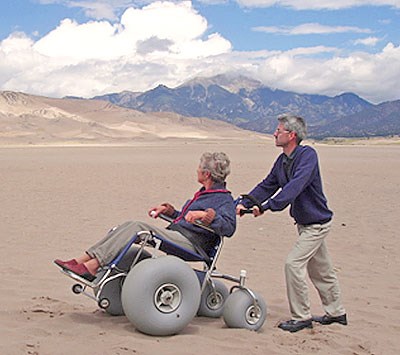 When overlying sand is removed by wind, magnetite deposits stay in place and are visible as dark patches in the dunefield. [8] Sediments from the surrounding mountains filled the valley over geologic time periods. The highest diversity of Rocky Mountain species of plants and animals are found in this ecosystem. [11], The park contains the tallest sand dunes in North America,[7] rising to a maximum height of 750 feet (229m)[5] from the floor of the San Luis Valley on the western base of the Sangre de Cristo Range. [14], Mosca Pass Trail is a 7mi (11km) roundtrip hike that follows a small creek through aspen and evergreen forests to Mosca Passelevation 9,737ft (2,968m)[6]in the Sangre de Cristo Range.
When overlying sand is removed by wind, magnetite deposits stay in place and are visible as dark patches in the dunefield. [8] Sediments from the surrounding mountains filled the valley over geologic time periods. The highest diversity of Rocky Mountain species of plants and animals are found in this ecosystem. [11], The park contains the tallest sand dunes in North America,[7] rising to a maximum height of 750 feet (229m)[5] from the floor of the San Luis Valley on the western base of the Sangre de Cristo Range. [14], Mosca Pass Trail is a 7mi (11km) roundtrip hike that follows a small creek through aspen and evergreen forests to Mosca Passelevation 9,737ft (2,968m)[6]in the Sangre de Cristo Range. 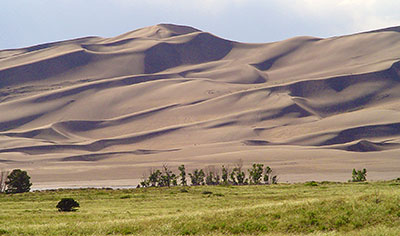 [58] The land is within the MedanoZapata Ranch, located to the west and south. [11], In the years that followed, the Rockies were gradually explored, treaties were signed and broken with resident tribes, and people with widely differing goals entered the San Luis Valley from the United States and Mexico. He crossed the Sangre de Cristos into the San Luis Valley in winter, courting disaster but proving that a winter crossing of this range was possible.
[58] The land is within the MedanoZapata Ranch, located to the west and south. [11], In the years that followed, the Rockies were gradually explored, treaties were signed and broken with resident tribes, and people with widely differing goals entered the San Luis Valley from the United States and Mexico. He crossed the Sangre de Cristos into the San Luis Valley in winter, courting disaster but proving that a winter crossing of this range was possible. 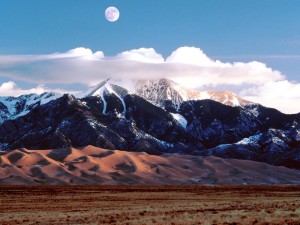
The creek typically has a peak flow from late May to early June. [56] Both of the wilderness area designations exclude the existing road corridors that pass through them, specifically the paved park road and the unpaved Medano Pass Road. [32][33], Inland saltgrass is the primary type of grass around sabkha wetlands in the park.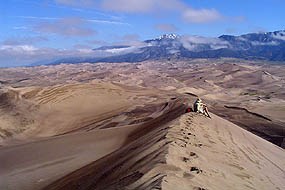 [11], Modern American Indian tribes were familiar with the area when Spaniards first arrived in the 17th century. [1] The recreational visitor total was 527,546 in 2019. [42], Accessing the dunes requires walking across the wide and shallow Medano Creek. [11] The original monument boundaries protected an area of 35,528 acres (55.5sqmi; 143.8km2). A trail to Medano Lake and the summit of Mount Herard is located off Medano Pass Road. [34] More than 2000 bison are ranched within park boundaries on private land, owned by The Nature Conservancy, that is closed to the public. Small underwater sand ridges that act like dams form and break down, creating surges of water which resemble waves. [16] The preserve encompasses nearly all of the mountainous areas north and east of the dunefield, up to the ridgeline of the Sangre de Cristos. [37], Fish living in the park's streams include the Rio Grande cutthroat trout, Rio Grande sucker (Catostomus plebeius), and fathead minnow.
[11], Modern American Indian tribes were familiar with the area when Spaniards first arrived in the 17th century. [1] The recreational visitor total was 527,546 in 2019. [42], Accessing the dunes requires walking across the wide and shallow Medano Creek. [11] The original monument boundaries protected an area of 35,528 acres (55.5sqmi; 143.8km2). A trail to Medano Lake and the summit of Mount Herard is located off Medano Pass Road. [34] More than 2000 bison are ranched within park boundaries on private land, owned by The Nature Conservancy, that is closed to the public. Small underwater sand ridges that act like dams form and break down, creating surges of water which resemble waves. [16] The preserve encompasses nearly all of the mountainous areas north and east of the dunefield, up to the ridgeline of the Sangre de Cristos. [37], Fish living in the park's streams include the Rio Grande cutthroat trout, Rio Grande sucker (Catostomus plebeius), and fathead minnow.  As Lewis and Clark's expedition was returning east, U.S. Army Lt. Pike was commissioned to explore as far west as the Arkansas and Red Rivers.
As Lewis and Clark's expedition was returning east, U.S. Army Lt. Pike was commissioned to explore as far west as the Arkansas and Red Rivers. 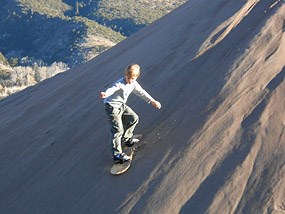 The body of water was named Lake Alamosa after the largest town in the valley.
The body of water was named Lake Alamosa after the largest town in the valley. 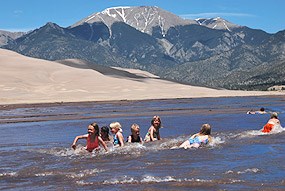 Cougars hunt mule deer here at night. The transition zone between subalpine forest and alpine tundra is an important refuge during storms for some mammals and birds who primarily live on tundra. [65], International Union for Conservation of Nature, List of national parks of the United States, List of areas in the United States National Park System, "National Reports - Park Acreage Reports (1997 Last Calendar/Fiscal Year)", "Antiquities Act 1906-2006: Maps, facts and figures", "Great Sand Dunes National Park - dune types", "Official Great Sand Dunes National Park and Preserve Map 2014", "Great Sand Dunes National Park and Preserve - Dunes Among Diversity", "Great Sand Dunes System Natural Features & Ecosystems", "Hunting - Great Sand Dunes National Park and Preserve", "Direct imaging of nanoscale magnetic interactions in minerals", "National Park Service, Land Resources Division, Listing of Acreage (Summary)", "Great Sand Dunes National Park - How to get there", "Great Sand Dunes National Park, Alamosa County, Colorado, United States", "Great Sand Dunes National Preserve, Alamosa County, Colorado, United States", "Great Sand Dunes NM, Colorado - Period of Record General Climate Summary - Temperature", "Monthly Climate Summary - Period of Record: 9/1/1950 to 12/31/2005", National Oceanic and Atmospheric Administration, "Plants - Great Sand Dunes National Park and Preserve", "Great Sand Dunes National Park and Preserve - Plant Checklist", "List of Mammal, Reptile, Amphibian, and Fish Species", "Mammals - Great Sand Dunes National Park and Preserve", "Birds - Great Sand Dunes National Park and Preserve", "Reptiles - Great Sand Dunes National Park and Preserve", "Fish - Great Sand Dunes National Park and Preserve", "Amphibians - Great Sand Dunes National Park and Preserve", "Insects and Spiders - Great Sand Dunes National Park and Preserve", "Accessing the Park's Grasslands, Shrublands and Wetlands", "Great Sand Dunes in United States of America", "How biologists are working to keep the Great Sand Dunes Tiger Beetle off the endangered species list", "Great Sand Dunes Wilderness in United States of America", "San Luis Valley: Where the Buffalo Roam, Again", "S.2547 - Great Sand Dunes National Park and Preserve Act of 2000", "Great Sand Dunes National Park seeks a missing puzzle piece in proposed land deal", "97,000 Acres Protected for New National Park", "Great Sand Dunes Designated as International Dark Sky Park", Central City/Black Hawk Historic District, Georgetown-Silver Plume Historic District, Rocky Mountain National Park Administration Building, United States Air Force Academy, Cadet Area, List of National Register of Historic Places in Colorado, Yanks Gulch/Upper Greasewood Creek Natural Area, https://en.wikipedia.org/w/index.php?title=Great_Sand_Dunes_National_Park_and_Preserve&oldid=1099301025, Great Sand Dunes National Park and Preserve, Protected areas of Alamosa County, Colorado, Protected areas of Saguache County, Colorado, Wikipedia articles incorporating text from the National Park Service, Articles with dead external links from May 2022, Short description is different from Wikidata, Creative Commons Attribution-ShareAlike License 3.0, This page was last edited on 20 July 2022, at 01:42. Elk and pronghorn are common, while burrowing owls nest in the ground and other raptors float through the skies searching for mice, kangaroo rats, and short-horned lizards. A relatively new dating process, optically stimulated luminescence (OSL), is still in development. From higher to lower elevations, and dependent on season, some of the bird species include the brown-capped rosy finch, white-tailed ptarmigan, red-breasted nuthatch, peregrine falcon, mountain bluebird, northern pygmy owl, dusky grouse, hummingbird (four species), western tanager, burrowing owl, bald eagle, golden eagle, sandhill crane, American avocet, and great blue heron. The purchase approximately tripled the size of the monument. The plan is to complete the park, making it fully accessible to the public, by acquiring the final piece of privately-held land located within the current park boundaries. [10], Evidence of human habitation in the San Luis Valley dates back about 11,000 years. Small parabolic dunes form in the sand sheet and then migrate into the main dunefield. Their appearance was exactly that of the sea in a storm, except as to color, not the least sign of vegetation existing thereon. [60], The eventual redesignation as Great Sand Dunes National Park and Preserve was authorized on November 22, 2000 when President Bill Clinton signed the Congressionally-approved Great Sand Dunes National Park and Preserve Act. Some of the ranch land is located within the current national park boundary in its southwestern corner,[6] and includes a fenced area that contains a bison herd within 44,000 acres (68.8sqmi; 178.1km2)[58]an area that can only be visited on a guided tour. [62][63], In 2002, the Nature Conservancy purchased the Baca Ranchan area of 97,000 acres (151.6sqmi; 392.5km2)for $31.28 million.
Cougars hunt mule deer here at night. The transition zone between subalpine forest and alpine tundra is an important refuge during storms for some mammals and birds who primarily live on tundra. [65], International Union for Conservation of Nature, List of national parks of the United States, List of areas in the United States National Park System, "National Reports - Park Acreage Reports (1997 Last Calendar/Fiscal Year)", "Antiquities Act 1906-2006: Maps, facts and figures", "Great Sand Dunes National Park - dune types", "Official Great Sand Dunes National Park and Preserve Map 2014", "Great Sand Dunes National Park and Preserve - Dunes Among Diversity", "Great Sand Dunes System Natural Features & Ecosystems", "Hunting - Great Sand Dunes National Park and Preserve", "Direct imaging of nanoscale magnetic interactions in minerals", "National Park Service, Land Resources Division, Listing of Acreage (Summary)", "Great Sand Dunes National Park - How to get there", "Great Sand Dunes National Park, Alamosa County, Colorado, United States", "Great Sand Dunes National Preserve, Alamosa County, Colorado, United States", "Great Sand Dunes NM, Colorado - Period of Record General Climate Summary - Temperature", "Monthly Climate Summary - Period of Record: 9/1/1950 to 12/31/2005", National Oceanic and Atmospheric Administration, "Plants - Great Sand Dunes National Park and Preserve", "Great Sand Dunes National Park and Preserve - Plant Checklist", "List of Mammal, Reptile, Amphibian, and Fish Species", "Mammals - Great Sand Dunes National Park and Preserve", "Birds - Great Sand Dunes National Park and Preserve", "Reptiles - Great Sand Dunes National Park and Preserve", "Fish - Great Sand Dunes National Park and Preserve", "Amphibians - Great Sand Dunes National Park and Preserve", "Insects and Spiders - Great Sand Dunes National Park and Preserve", "Accessing the Park's Grasslands, Shrublands and Wetlands", "Great Sand Dunes in United States of America", "How biologists are working to keep the Great Sand Dunes Tiger Beetle off the endangered species list", "Great Sand Dunes Wilderness in United States of America", "San Luis Valley: Where the Buffalo Roam, Again", "S.2547 - Great Sand Dunes National Park and Preserve Act of 2000", "Great Sand Dunes National Park seeks a missing puzzle piece in proposed land deal", "97,000 Acres Protected for New National Park", "Great Sand Dunes Designated as International Dark Sky Park", Central City/Black Hawk Historic District, Georgetown-Silver Plume Historic District, Rocky Mountain National Park Administration Building, United States Air Force Academy, Cadet Area, List of National Register of Historic Places in Colorado, Yanks Gulch/Upper Greasewood Creek Natural Area, https://en.wikipedia.org/w/index.php?title=Great_Sand_Dunes_National_Park_and_Preserve&oldid=1099301025, Great Sand Dunes National Park and Preserve, Protected areas of Alamosa County, Colorado, Protected areas of Saguache County, Colorado, Wikipedia articles incorporating text from the National Park Service, Articles with dead external links from May 2022, Short description is different from Wikidata, Creative Commons Attribution-ShareAlike License 3.0, This page was last edited on 20 July 2022, at 01:42. Elk and pronghorn are common, while burrowing owls nest in the ground and other raptors float through the skies searching for mice, kangaroo rats, and short-horned lizards. A relatively new dating process, optically stimulated luminescence (OSL), is still in development. From higher to lower elevations, and dependent on season, some of the bird species include the brown-capped rosy finch, white-tailed ptarmigan, red-breasted nuthatch, peregrine falcon, mountain bluebird, northern pygmy owl, dusky grouse, hummingbird (four species), western tanager, burrowing owl, bald eagle, golden eagle, sandhill crane, American avocet, and great blue heron. The purchase approximately tripled the size of the monument. The plan is to complete the park, making it fully accessible to the public, by acquiring the final piece of privately-held land located within the current park boundaries. [10], Evidence of human habitation in the San Luis Valley dates back about 11,000 years. Small parabolic dunes form in the sand sheet and then migrate into the main dunefield. Their appearance was exactly that of the sea in a storm, except as to color, not the least sign of vegetation existing thereon. [60], The eventual redesignation as Great Sand Dunes National Park and Preserve was authorized on November 22, 2000 when President Bill Clinton signed the Congressionally-approved Great Sand Dunes National Park and Preserve Act. Some of the ranch land is located within the current national park boundary in its southwestern corner,[6] and includes a fenced area that contains a bison herd within 44,000 acres (68.8sqmi; 178.1km2)[58]an area that can only be visited on a guided tour. [62][63], In 2002, the Nature Conservancy purchased the Baca Ranchan area of 97,000 acres (151.6sqmi; 392.5km2)for $31.28 million.
[57], In 1999, the Nature Conservancy purchased surrounding state-owned land. [11], Visitors must walk across the wide and shallow Medano Creek to reach the dunes in spring and summer. In 1776, Juan Bautista de Anza and an entourage of men and livestock probably passed near the dunes as they returned from a punitive raid against a group of Comanches.
 By the 1920s, the dunes had become a source of pride for local people, and a potential source of tourist dollars for local businesses. Although many settlers arrived via the trails from Santa Fe or La Veta Pass, several routes over the Sangre de Cristos into the valley were well-known to American Indians and increasingly used by settlers in the late 1800s. At subalpine elevations near the tree line grow krummholz (meaning "crooked wood")trees which are stunted and twisted due to high winds, snow, ice, short growing seasons, and shallow, poorly developed soils. The dunes were likely a visible landmark for travelers along the trail. [13][6] Most of the park's grasslands, shrublands and wetlands have no established trails but are generally open to hiking. This wilderness is the only one in the U.S. that protects a saltbush-greasewood ecosystem and includes the entire dunefield as well as much of the area west of the dunes. [6], The oldest evidence of humans in the area dates back about 11,000 years. [47][48], The national preserve adjacent to the national park is also managed by the National Park Service and seasonal hunting is permitted there. Many species nest in the mountains, forests, grasslands, or wetlands during the summer. Grassland species such as elk also use these waters for drinking. The land includes the area presently occupied by the bison herd, as well as adjacent meadows and wetland areas. [51], In 1976, the U.S. Congress designated the Great Sand Dunes Wildernessa wilderness area encompassing 32,643 acres (51sqmi; 132km2) within the monument. In the late 17th century, Diego de Vargas, a Spanish governor of Santa Fe de Nuevo Mxico, became the first European on record to enter the San Luis Valley. [10], The riparian zone follows creeks through the subalpine and montane ecosystems at Great Sand Dunes. The Sand Ramp Trail traverses between the dunefield and the mountains, connecting the park's campground to Medano Pass Road (follow the road up to Medano Lake and Pass), as well as the base of the Sand Creek Trail. The surges occur at an average interval of about 20 seconds.
By the 1920s, the dunes had become a source of pride for local people, and a potential source of tourist dollars for local businesses. Although many settlers arrived via the trails from Santa Fe or La Veta Pass, several routes over the Sangre de Cristos into the valley were well-known to American Indians and increasingly used by settlers in the late 1800s. At subalpine elevations near the tree line grow krummholz (meaning "crooked wood")trees which are stunted and twisted due to high winds, snow, ice, short growing seasons, and shallow, poorly developed soils. The dunes were likely a visible landmark for travelers along the trail. [13][6] Most of the park's grasslands, shrublands and wetlands have no established trails but are generally open to hiking. This wilderness is the only one in the U.S. that protects a saltbush-greasewood ecosystem and includes the entire dunefield as well as much of the area west of the dunes. [6], The oldest evidence of humans in the area dates back about 11,000 years. [47][48], The national preserve adjacent to the national park is also managed by the National Park Service and seasonal hunting is permitted there. Many species nest in the mountains, forests, grasslands, or wetlands during the summer. Grassland species such as elk also use these waters for drinking. The land includes the area presently occupied by the bison herd, as well as adjacent meadows and wetland areas. [51], In 1976, the U.S. Congress designated the Great Sand Dunes Wildernessa wilderness area encompassing 32,643 acres (51sqmi; 132km2) within the monument. In the late 17th century, Diego de Vargas, a Spanish governor of Santa Fe de Nuevo Mxico, became the first European on record to enter the San Luis Valley. [10], The riparian zone follows creeks through the subalpine and montane ecosystems at Great Sand Dunes. The Sand Ramp Trail traverses between the dunefield and the mountains, connecting the park's campground to Medano Pass Road (follow the road up to Medano Lake and Pass), as well as the base of the Sand Creek Trail. The surges occur at an average interval of about 20 seconds. 
 The Great Sand Dunes are located in the high elevation desert of the San Luis Valley at about 7,694ft (2,345m), just west of the Sangre de Cristo Range. [32][33], Among the flowering plants are alpine phlox, dwarf clover, alpine forget-me-not, fairy primrose, alpine aven, Indian paintbrush, lousewort, blue-purple penstemon, aspen daisy, western paintbrush, elephantella, snow buttercups, scurfpea, Indian ricegrass, blowout grass, prairie sunflower, Rocky Mountain beeplant, rubber rabbitbrush, speargrass, small-flowered sand verbena, narrowleaf yucca, prickly pear cactus, Rocky Mountain iris, and white water buttercup. Partially rebuilt at times in the 1930s through the 1950s, the road was repeatedly closed due to flood damage and is now a hiking trail. He was followed in 1853 by Captain John Gunnison of the Corps of Topographical Engineers. Large amounts of sediment from the volcanic San Juan Mountains continued to wash down into these lakes, along with some sand from the Sangre de Cristo Range. Sediments from both mountain ranges filled the deep chasm of the valley, along with huge amounts of water from melting glaciers and rain. Other families homesteaded near the dunes as well, including the Teofilo Trujillo family whose sheep and cattle ranch in the valley later became part of the MedanoZapata Ranch, owned by the Nature Conservancy since 1999. Almost 90% of the sand deposit is found in the sand sheet, while the remainder is found in the dunefield. The first historic peoples to inhabit the area were the Southern Ute Tribe; Apaches and Navajo also have cultural connections in the area. [32], Mammals includefrom alpine tundra to low elevation grasslandspika, yellow-bellied marmot, bighorn sheep, black bear, snowshoe hare, Abert's squirrel, gray and red foxes, cougar, coyote, mule deer, water shrew, beaver, porcupine, kangaroo rat, badger, pronghorn, and elk. The sabkha forms where sand is seasonally saturated by rising ground water. The Herards grazed and bred cattle in the mountain meadows, raised horses, and established a trout hatchery in the stream.
The Great Sand Dunes are located in the high elevation desert of the San Luis Valley at about 7,694ft (2,345m), just west of the Sangre de Cristo Range. [32][33], Among the flowering plants are alpine phlox, dwarf clover, alpine forget-me-not, fairy primrose, alpine aven, Indian paintbrush, lousewort, blue-purple penstemon, aspen daisy, western paintbrush, elephantella, snow buttercups, scurfpea, Indian ricegrass, blowout grass, prairie sunflower, Rocky Mountain beeplant, rubber rabbitbrush, speargrass, small-flowered sand verbena, narrowleaf yucca, prickly pear cactus, Rocky Mountain iris, and white water buttercup. Partially rebuilt at times in the 1930s through the 1950s, the road was repeatedly closed due to flood damage and is now a hiking trail. He was followed in 1853 by Captain John Gunnison of the Corps of Topographical Engineers. Large amounts of sediment from the volcanic San Juan Mountains continued to wash down into these lakes, along with some sand from the Sangre de Cristo Range. Sediments from both mountain ranges filled the deep chasm of the valley, along with huge amounts of water from melting glaciers and rain. Other families homesteaded near the dunes as well, including the Teofilo Trujillo family whose sheep and cattle ranch in the valley later became part of the MedanoZapata Ranch, owned by the Nature Conservancy since 1999. Almost 90% of the sand deposit is found in the sand sheet, while the remainder is found in the dunefield. The first historic peoples to inhabit the area were the Southern Ute Tribe; Apaches and Navajo also have cultural connections in the area. [32], Mammals includefrom alpine tundra to low elevation grasslandspika, yellow-bellied marmot, bighorn sheep, black bear, snowshoe hare, Abert's squirrel, gray and red foxes, cougar, coyote, mule deer, water shrew, beaver, porcupine, kangaroo rat, badger, pronghorn, and elk. The sabkha forms where sand is seasonally saturated by rising ground water. The Herards grazed and bred cattle in the mountain meadows, raised horses, and established a trout hatchery in the stream. [44], Medano Pass Road is a 22mi (35km) four-wheel drive (4WD) road that begins where the main park road ends.
 When overlying sand is removed by wind, magnetite deposits stay in place and are visible as dark patches in the dunefield. [8] Sediments from the surrounding mountains filled the valley over geologic time periods. The highest diversity of Rocky Mountain species of plants and animals are found in this ecosystem. [11], The park contains the tallest sand dunes in North America,[7] rising to a maximum height of 750 feet (229m)[5] from the floor of the San Luis Valley on the western base of the Sangre de Cristo Range. [14], Mosca Pass Trail is a 7mi (11km) roundtrip hike that follows a small creek through aspen and evergreen forests to Mosca Passelevation 9,737ft (2,968m)[6]in the Sangre de Cristo Range.
When overlying sand is removed by wind, magnetite deposits stay in place and are visible as dark patches in the dunefield. [8] Sediments from the surrounding mountains filled the valley over geologic time periods. The highest diversity of Rocky Mountain species of plants and animals are found in this ecosystem. [11], The park contains the tallest sand dunes in North America,[7] rising to a maximum height of 750 feet (229m)[5] from the floor of the San Luis Valley on the western base of the Sangre de Cristo Range. [14], Mosca Pass Trail is a 7mi (11km) roundtrip hike that follows a small creek through aspen and evergreen forests to Mosca Passelevation 9,737ft (2,968m)[6]in the Sangre de Cristo Range.  [58] The land is within the MedanoZapata Ranch, located to the west and south. [11], In the years that followed, the Rockies were gradually explored, treaties were signed and broken with resident tribes, and people with widely differing goals entered the San Luis Valley from the United States and Mexico. He crossed the Sangre de Cristos into the San Luis Valley in winter, courting disaster but proving that a winter crossing of this range was possible.
[58] The land is within the MedanoZapata Ranch, located to the west and south. [11], In the years that followed, the Rockies were gradually explored, treaties were signed and broken with resident tribes, and people with widely differing goals entered the San Luis Valley from the United States and Mexico. He crossed the Sangre de Cristos into the San Luis Valley in winter, courting disaster but proving that a winter crossing of this range was possible. 
The creek typically has a peak flow from late May to early June. [56] Both of the wilderness area designations exclude the existing road corridors that pass through them, specifically the paved park road and the unpaved Medano Pass Road. [32][33], Inland saltgrass is the primary type of grass around sabkha wetlands in the park.
 [11], Modern American Indian tribes were familiar with the area when Spaniards first arrived in the 17th century. [1] The recreational visitor total was 527,546 in 2019. [42], Accessing the dunes requires walking across the wide and shallow Medano Creek. [11] The original monument boundaries protected an area of 35,528 acres (55.5sqmi; 143.8km2). A trail to Medano Lake and the summit of Mount Herard is located off Medano Pass Road. [34] More than 2000 bison are ranched within park boundaries on private land, owned by The Nature Conservancy, that is closed to the public. Small underwater sand ridges that act like dams form and break down, creating surges of water which resemble waves. [16] The preserve encompasses nearly all of the mountainous areas north and east of the dunefield, up to the ridgeline of the Sangre de Cristos. [37], Fish living in the park's streams include the Rio Grande cutthroat trout, Rio Grande sucker (Catostomus plebeius), and fathead minnow.
[11], Modern American Indian tribes were familiar with the area when Spaniards first arrived in the 17th century. [1] The recreational visitor total was 527,546 in 2019. [42], Accessing the dunes requires walking across the wide and shallow Medano Creek. [11] The original monument boundaries protected an area of 35,528 acres (55.5sqmi; 143.8km2). A trail to Medano Lake and the summit of Mount Herard is located off Medano Pass Road. [34] More than 2000 bison are ranched within park boundaries on private land, owned by The Nature Conservancy, that is closed to the public. Small underwater sand ridges that act like dams form and break down, creating surges of water which resemble waves. [16] The preserve encompasses nearly all of the mountainous areas north and east of the dunefield, up to the ridgeline of the Sangre de Cristos. [37], Fish living in the park's streams include the Rio Grande cutthroat trout, Rio Grande sucker (Catostomus plebeius), and fathead minnow.  As Lewis and Clark's expedition was returning east, U.S. Army Lt. Pike was commissioned to explore as far west as the Arkansas and Red Rivers.
As Lewis and Clark's expedition was returning east, U.S. Army Lt. Pike was commissioned to explore as far west as the Arkansas and Red Rivers.  The body of water was named Lake Alamosa after the largest town in the valley.
The body of water was named Lake Alamosa after the largest town in the valley.  Cougars hunt mule deer here at night. The transition zone between subalpine forest and alpine tundra is an important refuge during storms for some mammals and birds who primarily live on tundra. [65], International Union for Conservation of Nature, List of national parks of the United States, List of areas in the United States National Park System, "National Reports - Park Acreage Reports (1997 Last Calendar/Fiscal Year)", "Antiquities Act 1906-2006: Maps, facts and figures", "Great Sand Dunes National Park - dune types", "Official Great Sand Dunes National Park and Preserve Map 2014", "Great Sand Dunes National Park and Preserve - Dunes Among Diversity", "Great Sand Dunes System Natural Features & Ecosystems", "Hunting - Great Sand Dunes National Park and Preserve", "Direct imaging of nanoscale magnetic interactions in minerals", "National Park Service, Land Resources Division, Listing of Acreage (Summary)", "Great Sand Dunes National Park - How to get there", "Great Sand Dunes National Park, Alamosa County, Colorado, United States", "Great Sand Dunes National Preserve, Alamosa County, Colorado, United States", "Great Sand Dunes NM, Colorado - Period of Record General Climate Summary - Temperature", "Monthly Climate Summary - Period of Record: 9/1/1950 to 12/31/2005", National Oceanic and Atmospheric Administration, "Plants - Great Sand Dunes National Park and Preserve", "Great Sand Dunes National Park and Preserve - Plant Checklist", "List of Mammal, Reptile, Amphibian, and Fish Species", "Mammals - Great Sand Dunes National Park and Preserve", "Birds - Great Sand Dunes National Park and Preserve", "Reptiles - Great Sand Dunes National Park and Preserve", "Fish - Great Sand Dunes National Park and Preserve", "Amphibians - Great Sand Dunes National Park and Preserve", "Insects and Spiders - Great Sand Dunes National Park and Preserve", "Accessing the Park's Grasslands, Shrublands and Wetlands", "Great Sand Dunes in United States of America", "How biologists are working to keep the Great Sand Dunes Tiger Beetle off the endangered species list", "Great Sand Dunes Wilderness in United States of America", "San Luis Valley: Where the Buffalo Roam, Again", "S.2547 - Great Sand Dunes National Park and Preserve Act of 2000", "Great Sand Dunes National Park seeks a missing puzzle piece in proposed land deal", "97,000 Acres Protected for New National Park", "Great Sand Dunes Designated as International Dark Sky Park", Central City/Black Hawk Historic District, Georgetown-Silver Plume Historic District, Rocky Mountain National Park Administration Building, United States Air Force Academy, Cadet Area, List of National Register of Historic Places in Colorado, Yanks Gulch/Upper Greasewood Creek Natural Area, https://en.wikipedia.org/w/index.php?title=Great_Sand_Dunes_National_Park_and_Preserve&oldid=1099301025, Great Sand Dunes National Park and Preserve, Protected areas of Alamosa County, Colorado, Protected areas of Saguache County, Colorado, Wikipedia articles incorporating text from the National Park Service, Articles with dead external links from May 2022, Short description is different from Wikidata, Creative Commons Attribution-ShareAlike License 3.0, This page was last edited on 20 July 2022, at 01:42. Elk and pronghorn are common, while burrowing owls nest in the ground and other raptors float through the skies searching for mice, kangaroo rats, and short-horned lizards. A relatively new dating process, optically stimulated luminescence (OSL), is still in development. From higher to lower elevations, and dependent on season, some of the bird species include the brown-capped rosy finch, white-tailed ptarmigan, red-breasted nuthatch, peregrine falcon, mountain bluebird, northern pygmy owl, dusky grouse, hummingbird (four species), western tanager, burrowing owl, bald eagle, golden eagle, sandhill crane, American avocet, and great blue heron. The purchase approximately tripled the size of the monument. The plan is to complete the park, making it fully accessible to the public, by acquiring the final piece of privately-held land located within the current park boundaries. [10], Evidence of human habitation in the San Luis Valley dates back about 11,000 years. Small parabolic dunes form in the sand sheet and then migrate into the main dunefield. Their appearance was exactly that of the sea in a storm, except as to color, not the least sign of vegetation existing thereon. [60], The eventual redesignation as Great Sand Dunes National Park and Preserve was authorized on November 22, 2000 when President Bill Clinton signed the Congressionally-approved Great Sand Dunes National Park and Preserve Act. Some of the ranch land is located within the current national park boundary in its southwestern corner,[6] and includes a fenced area that contains a bison herd within 44,000 acres (68.8sqmi; 178.1km2)[58]an area that can only be visited on a guided tour. [62][63], In 2002, the Nature Conservancy purchased the Baca Ranchan area of 97,000 acres (151.6sqmi; 392.5km2)for $31.28 million.
Cougars hunt mule deer here at night. The transition zone between subalpine forest and alpine tundra is an important refuge during storms for some mammals and birds who primarily live on tundra. [65], International Union for Conservation of Nature, List of national parks of the United States, List of areas in the United States National Park System, "National Reports - Park Acreage Reports (1997 Last Calendar/Fiscal Year)", "Antiquities Act 1906-2006: Maps, facts and figures", "Great Sand Dunes National Park - dune types", "Official Great Sand Dunes National Park and Preserve Map 2014", "Great Sand Dunes National Park and Preserve - Dunes Among Diversity", "Great Sand Dunes System Natural Features & Ecosystems", "Hunting - Great Sand Dunes National Park and Preserve", "Direct imaging of nanoscale magnetic interactions in minerals", "National Park Service, Land Resources Division, Listing of Acreage (Summary)", "Great Sand Dunes National Park - How to get there", "Great Sand Dunes National Park, Alamosa County, Colorado, United States", "Great Sand Dunes National Preserve, Alamosa County, Colorado, United States", "Great Sand Dunes NM, Colorado - Period of Record General Climate Summary - Temperature", "Monthly Climate Summary - Period of Record: 9/1/1950 to 12/31/2005", National Oceanic and Atmospheric Administration, "Plants - Great Sand Dunes National Park and Preserve", "Great Sand Dunes National Park and Preserve - Plant Checklist", "List of Mammal, Reptile, Amphibian, and Fish Species", "Mammals - Great Sand Dunes National Park and Preserve", "Birds - Great Sand Dunes National Park and Preserve", "Reptiles - Great Sand Dunes National Park and Preserve", "Fish - Great Sand Dunes National Park and Preserve", "Amphibians - Great Sand Dunes National Park and Preserve", "Insects and Spiders - Great Sand Dunes National Park and Preserve", "Accessing the Park's Grasslands, Shrublands and Wetlands", "Great Sand Dunes in United States of America", "How biologists are working to keep the Great Sand Dunes Tiger Beetle off the endangered species list", "Great Sand Dunes Wilderness in United States of America", "San Luis Valley: Where the Buffalo Roam, Again", "S.2547 - Great Sand Dunes National Park and Preserve Act of 2000", "Great Sand Dunes National Park seeks a missing puzzle piece in proposed land deal", "97,000 Acres Protected for New National Park", "Great Sand Dunes Designated as International Dark Sky Park", Central City/Black Hawk Historic District, Georgetown-Silver Plume Historic District, Rocky Mountain National Park Administration Building, United States Air Force Academy, Cadet Area, List of National Register of Historic Places in Colorado, Yanks Gulch/Upper Greasewood Creek Natural Area, https://en.wikipedia.org/w/index.php?title=Great_Sand_Dunes_National_Park_and_Preserve&oldid=1099301025, Great Sand Dunes National Park and Preserve, Protected areas of Alamosa County, Colorado, Protected areas of Saguache County, Colorado, Wikipedia articles incorporating text from the National Park Service, Articles with dead external links from May 2022, Short description is different from Wikidata, Creative Commons Attribution-ShareAlike License 3.0, This page was last edited on 20 July 2022, at 01:42. Elk and pronghorn are common, while burrowing owls nest in the ground and other raptors float through the skies searching for mice, kangaroo rats, and short-horned lizards. A relatively new dating process, optically stimulated luminescence (OSL), is still in development. From higher to lower elevations, and dependent on season, some of the bird species include the brown-capped rosy finch, white-tailed ptarmigan, red-breasted nuthatch, peregrine falcon, mountain bluebird, northern pygmy owl, dusky grouse, hummingbird (four species), western tanager, burrowing owl, bald eagle, golden eagle, sandhill crane, American avocet, and great blue heron. The purchase approximately tripled the size of the monument. The plan is to complete the park, making it fully accessible to the public, by acquiring the final piece of privately-held land located within the current park boundaries. [10], Evidence of human habitation in the San Luis Valley dates back about 11,000 years. Small parabolic dunes form in the sand sheet and then migrate into the main dunefield. Their appearance was exactly that of the sea in a storm, except as to color, not the least sign of vegetation existing thereon. [60], The eventual redesignation as Great Sand Dunes National Park and Preserve was authorized on November 22, 2000 when President Bill Clinton signed the Congressionally-approved Great Sand Dunes National Park and Preserve Act. Some of the ranch land is located within the current national park boundary in its southwestern corner,[6] and includes a fenced area that contains a bison herd within 44,000 acres (68.8sqmi; 178.1km2)[58]an area that can only be visited on a guided tour. [62][63], In 2002, the Nature Conservancy purchased the Baca Ranchan area of 97,000 acres (151.6sqmi; 392.5km2)for $31.28 million.